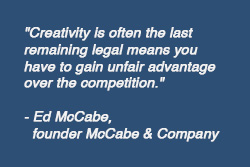Insight Marketing Blog
Effective Marketing Takes Creative Risk
“Safe advertising is the riskiest advertising you can do.”
– Bill Bernbach, Co-founder, BBD Advertising Agency
 Creativity is what sells, and being creative means taking risks.
Creativity is what sells, and being creative means taking risks.In my book, Branding Insights for Small Business, I point out that creativity is marketing’s most underutilized tool. An ad, brochure or website is just a delivery method for a sales message – it’s the creativity in that message that most determines how effectively it performs!
It’s an easy fact to forget in today’s technology-rich environment, where data dominates most marketing conversations. The right data can help a small business level the playing field against larger competitors when it comes to reaching the right audience at the right time. But tipping the scales in your favor requires getting your customers’ attention with a unique and memorable idea.
T. Taylor, founder of The Creative Alliance, agrees: “Instead of taking a potentially bigger creative risk, too many [businesses] settle for safety and taking the route most traveled.” He thinks what many business leaders lack is creative courage – the willingness to put themselves out there. “I like the questions, ‘What if?’ and ‘Why not?’ when thinking of new ways to do things,” he says. “Everything is possible when you have creative courage.”
Champion Creativity and Risk
Recall the last ad that caught your attention. What was it that made it stand out? Was it funny? Beautifully designed? Did it make you look at the product or service in a new way?
With the glut of advertising and marketing that saturates our daily lives, your message must capture your customer’s attention – it doesn’t need to win awards, but it should strive to amuse, captivate, tell a story or provoke thought.
Why is so much advertising so formulaic and uninspired? Because many large companies tend to be conservative and a “cover your ass” mindset prevails with many marketing and product managers. It’s better, they reason, not to stick their neck out too far (and possibly lose it) with a risky new idea that might fail. Smaller businesses tend to follow suit, mimicking what their larger competitors are doing.
Then, when a competitor comes along with a bold, new creative idea, the “me-too” marketers break out it in a sweat as they hustle to catch up.
Thinking Creatively
What does a truly creative idea look like? Don’t look to what’s been done before, except for inspiration – look to what will surprise and delight your customers.

Try to approach every new marketing idea with the same blank slate your customers will bring to it. They don’t know a thing about your strategy or your positioning. They’ll be ready to move on in seconds if you don’t grab their attention.
So be cognizant of your first impression. Don’t over-evaluate a creative idea or you’ll start to second-guess its effectiveness. The same thing happens when ideas are passed around between departments for input and approval. You just can’t make creative decisions by committee. Before you know it a great idea gets pushed aside in favor of the consensus winner – usually the safer and least effective choice.
Go For The Big Idea
In his book Ogilvy on Advertising, legendary ad man David Ogilvy suggests asking the following questions to spot a big idea:
- Did it make me gasp when I first saw it?
- Do I wish I had thought of it myself?
- Is it unique?
- Does it fit the strategy to perfection?
- Could it be used for 30 years?
Big ideas are simple and easy to understand. They’re easily adapted to different campaigns, media and tactics, and they can be implemented with various creative ideas and executions.

Take Nike, for example. Its big idea? They saw the fitness trend exploding in the late 1980s, but also understood that not everyone was going to run a marathon. (At the time Nike marketed exclusively to marathon runners.) Their “Just Do It” campaign was short and sweet, yet encapsulated everything people felt about exercising. Don’t feel like running today? Just Do It. Don’t feel like taking the stairs instead of the elevator? Just Do It. And that feeling remains the same today, which is why the campaign was so successful.
Exercise your creative courage and think big if you want to stand out. Push the creative envelope, and you’re more likely to come up with something that has a real impact. Remember what another advertising legend, Leo Burnett, suggests: “When you reach for the stars, you may not quite get one, but you won’t come up with a handful of mud either.”
Continue reading →
The Top 7 Marketing Trends for 2015
Where are marketers’ biggest opportunities this year?
 Big Data, personalization and precision targeting are trends to watch in 2015.
Big Data, personalization and precision targeting are trends to watch in 2015.It’s interesting to think just how far marketing has come since I began in the business more than 30 years ago. If I had tried to describe 2015 then, I don’t think I’d have done much better than Back to the Future II.
That’s why you don’t see many prognosticators predicting trends decades from now, much less 10 or even five years. One year’s a safer bet. Eagle-eyed marketers can spot new trends emerging months before they gain critical mass, and use it to their advantage.
Many of the trends we highlighted in last year’s blog post are still going strong: mobile marketing, branding, integrated marketing – so this year’s may look familiar. Visual marketing continues to be important as businesses fight for their share of fragmented attention spans. Mobile isn’t going anywhere (with a few new developments we’ll discuss), and businesses will keep producing useful content to provide more value to their customers.
Now let’s look at what’s new for 2015.
1. Organic Search – Not What It Used to Be
Organic search listings continue to get pushed farther down the page, as search engines seek to maximize revenue from paid advertising. Many marketers will take this as a cue to invest more heavily in paid search marketing, which will require a larger focus on campaign optimization.
And Google’s recent updates to its search algorithms have made it next to impossible to game the system with old SEO methods like keyword stuffing or creating hundreds of inbound links from low-quality websites. To achieve high rankings in organic search results now requires frequent updates to your website with original and engaging content that’s written for your customers, not googlebots.
2. Data-Driven Marketing Becomes the Norm
There’s never been as much information available about how consumers act online – what’s now known as “Big Data.” And marketers have begun to embrace statistical analysis to stay ahead of both consumers and competitors.
Website analytics, email metrics, first- and third-party data all combine to create an impressively detailed picture of your prospects. Marketing automation tools make it easier to personalize marketing messages and reach those consumers at the right time, across media channels. Digital ads can target ever more granular audiences by leveraging data on geography, demographics, behavior, interests and preferred mobile devices.
Which is why …
3. Hyper-Targeted Advertising Gains Momentum
The buzzword for 2014 was “programmatic,” a system that combines automated ad buying with highly targeted digital ad placement. Programmatic buying is all about precision, resulting in a more efficient use of advertising dollars than the usual process of purchasing digital ads manually through various ad networks.
In general, targeted ads and personalization will continue to grow as the mountains of consumer data let businesses send more and more relevant messages.
4. Social Media Keeps Evolving
Social media channels are constantly devising new types of advertising, both to apply new technologies and stay a step ahead of jaded users. That spells opportunity for marketers. Even platforms like Tumblr and Snapchat – big with Millennials who are wary of marketing – are getting into the ad game. For 2015, marketers will look beyond the standard sponsored ads on Twitter and Facebook and find new, creative ways to interact with their customers through social media.
5. News Media Makes a Comeback
By now it’s accepted wisdom: newspapers are dying. But that’s not entirely true. While print readership is in decline, media companies long ago began migrating their content online.
More recently, savvy newspapers have realized their unique strength lies not just in their large and loyal audiences, but in the data they produce. In addition to regional or local reach, marketers can target more and more specific audience segments based on the content they consume. And newspaper readers now get most news via mobile devices – a terrific opportunity for advertisers who need to connect with audiences on the go.
Which brings us to …
6. Mobile is Still on the Move
The fact that mobile usage outpaced desktops in 2014 is probably no surprise. Mobile search is predicted to surpass desktop search in 2015, too. And that growth won’t stop at just smartphones and tablets.
Wearable technology like the iWatch will find its footing this year, leading marketers to test ways to make the best use of these new platforms. (This will have a big effect on brick-and-mortar, too, as mobile payment systems like ApplePay take off.) Add in the “Internet of Things” – everyday objects connected to the internet – and the possibilities are limited only by marketers’ imaginations.
7. More Human Brands
Today consumers expect more from brands, particularly aging Millennials. Like real-time customer service on Twitter. Accountability and sustainability. Novel experiences or useful tools that enrich their lives. Brand values they can relate to, and companies that are responsive, not empty marketing speak.
Authentic brands are no longer a positioning gimmick, they’re a necessity. (I would argue this has been the best position to take all along.) Both good and bad brand experiences are quickly amplified across the internet, and it’s getting harder to avoid real human-to-human interactions.
Conclusion
In general, marketing in 2015 will be marked by ever-fading lines between marketing channels. The technologies that make this possible will take center stage, helping marketers tell more cohesive brand stories (and at the same time more personalized), everywhere their customers are. And thanks to today’s skeptical, connected consumer, those stories will have to be rooted in transparency and authenticity – your customers will see through anything else.
Continue reading →The Most Important Thing Companies Overlook in Their Marketing
 Think about what you should say, before you decide where to say it.
Think about what you should say, before you decide where to say it.It’s the foundation of an effective marketing strategy.
In my more than 30 years helping businesses build better marketing strategies, the thing they want to discuss most is marketing tactics: How can we get in front of more potential customers? (Usually followed by: How much will it cost us?)
Tactics and budget are indeed important considerations, but not the most important. Before worrying where your message will appear, you need to first examine what that message should communicate and why. It’s the message at the heart of your marketing strategy that determines whether you’ll ultimately cut through the noise and win a distinct place in consumers’ minds.
In order to accomplish that, your message must be different, unique. It has to make a clear promise your competitors can’t, or at least one they haven’t thought to make yet. In this way, your brand stands for something singular and specific and memorable. It’s called positioning – how you claim a niche and plant your flag in the marketplace.
Take, for example, two of the nation’s leading insurance companies: State Farm and American Family Insurance. State Farm wants you to know it’s “like a good neighbor” – there when you need them. But American Family Insurance wants to “protect your dreams,” whether that’s a long healthy life or the 48’ fishing boat you scraped and saved to buy.
Both companies have staked out a positioning that distinguishes their businesses from competitors in the minds of consumers. Before meeting with an agent or digging into the finer points of insurance plans, consumers can take a shortcut by deciding which brand message resonates with them.
The Unique Selling Proposition
Positioning starts with understanding your target customer, what they want, and what benefit you offer that best meets those needs. Unfortunately, that’s not always enough. Your competitors may offer the same products or services with the same essential benefit. It requires thinking creatively about how you deliver on that promise, and how to do it in a way that sets your solution apart.
One way to find clarity around your positioning is to use a concept called the Unique Selling Proposition (or USP for short).
The Unique Selling Proposition has been around since the 1960s. It was conceived by Rosser Reeves, one of advertising’s most influential figures. First presented in his book “Reality in Advertising,” Reeves says that a successful USP contains four key elements:
- It must make a specific proposition to the customer: Buy this product and you will get this specific benefit.
- The proposition must be unique or perceived as unique by your customers. Something your competitors don’t have or offer, and something in which they would not be able to easily imitate.
- It should be so compelling and relevant to your ideal customers that it entices them to try your product or service because it addresses their needs, fears, frustrations or desires.
- It must be simple and easy to communicate so your customers quickly understand that your product or service offers them this unique benefit.
You may remember Mr. Reeves’ famous USP for M&M Candies – “It melts in your mouth, not in your hand.” Another example is FedEx’s “When it absolutely, positively has to get there overnight,” and Wonderbread’s “Helps to build strong bodies in 12 different ways.”
Finding Your USP
In order to arrive at your own USP, ask yourself these questions:
- What’s your competitive advantage, if any?
- What value does your business add beyond the primary benefit? What unique approach, philosophy or point of view can you tout?
- What are specific issues your customers face when thinking about, shopping for, or using your product or service? How can you address these with your positioning?
- How can you speak to the emotional, as well as logical reasons people should do business with you?
- What can you do differently than you or doing now to improve on your primary benefit? What new capabilities or services can you add that will make a noticeable impact?
- Somewhere in those answers lies the key to your competitive positioning. List as many possibilities as you can, and winnow the list down to the most distinctive and promising options.
Once you’ve decided on your USP, create a positioning statement for your business that can be referred to when shaping your brand or marketing message. A common formula for a positioning statement looks like this:
For (the target customer) who (customer need or opportunity), the (product or service) delivers (statement of key benefit). Unlike (competitors), our solution (USP – what makes your promise different).
Now you’re thinking strategically. Find creative ways to communicate your positioning in every campaign, across different tactics, and you’re investing in a strong brand message, not just the media that will carry it.
Does your company have a well-defined positioning? How did you approach it? Tell us in the comments below.
Continue reading →